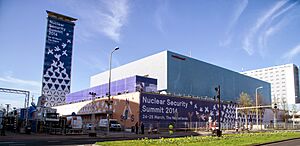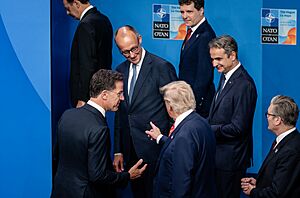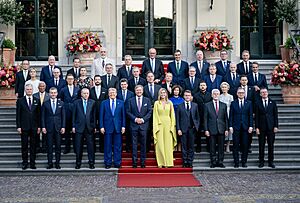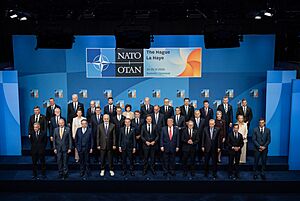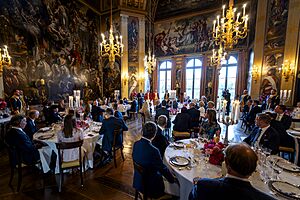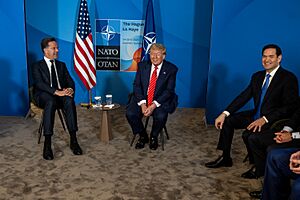2025 The Hague NATO summit facts for kids
Quick facts for kids NATO Summit The Hague 2025The Hague•La Haye 24–25 VI 2025 Summit•Sommet |
|
|---|---|
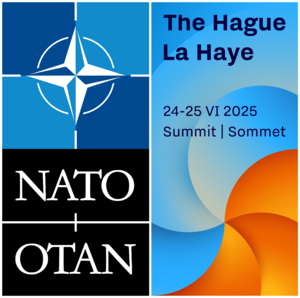 |
|
| Host country | Netherlands |
| Date | 24–25 June 2025 |
| Venue(s) | World Forum |
| Cities | The Hague |
| Follows | 2024 Washington NATO summit |
| Precedes | 2026 Ankara NATO summit |
The 2025 The Hague summit was an important meeting for NATO, the North Atlantic Treaty Organization. Leaders from 32 member countries, along with their partners and the European Union, gathered in The Hague, Netherlands, on June 24–25, 2025.
This was the first time the Netherlands hosted a NATO summit. It was also the first summit for the new NATO Secretary General, Mark Rutte. He used to be the Prime Minister of the Netherlands and is from The Hague. A main goal of the summit was for member countries to promise to spend more on defense, aiming for five percent of their country's total economic output (called GDP).
Some countries from outside the Atlantic area, like New Zealand and Japan, also sent representatives. Important one-on-one meetings happened during the summit. For example, US President Donald Trump met separately with Ukrainian President Volodymyr Zelenskyy and Turkish President Recep Tayyip Erdoğan.
Contents
Why The Hague Hosted the Summit
It was decided at the 2023 Vilnius NATO summit that the Netherlands would host the 2025 meeting. This was a first for the country. The exact location, the World Forum in The Hague, was announced in May 2024. The World Forum had hosted other big meetings before, like the 2014 Nuclear Security Summit.
Willem-Alexander, the King of the Netherlands, visited the venue on June 23 to check its readiness. During the summit, it became clear that the Dutch royal family played a key role in talking with Donald Trump. Their goal was to keep him interested and involved with the NATO alliance.
Before the summit, several countries discussed what they hoped to achieve. Some European nations wanted a plan to deal with possible money problems if the US reduced its NATO contributions. The US currently pays a large part of NATO's defense budget. NATO also suggested that Europe and Canada should increase their weapon and equipment supplies by 30 percent. However, this multi-year plan was not discussed at the summit.
The United States had pushed for each member to spend at least 5% of its GDP on defense. This push became stronger after Donald Trump was elected in 2024. In response, Poland announced it would increase its defense spending to 4.7% of GDP. The Netherlands also committed to increasing its defense budget to 3.5% of GDP, with an extra 1.5% for related defense areas, to reach the 5% goal.
Defense ministers from the Baltic states also stressed the need for more NATO contributions. The Estonian Defense Minister, Hanno Pevkur, said that Baltic countries had already increased their spending. He added that all allies needed to understand this importance.
What Happened at the Summit
The 2025 NATO summit in The Hague successfully focused on increasing NATO members' yearly defense spending. The new goal was a 5% spending target. In his first speech as NATO Secretary General, Mark Rutte urged the alliance to "shift to a wartime mindset." He also called for boosting defense production and spending.
The new 5% spending target was divided into two parts. First, 3.5% must go to direct military costs like salaries, weapons, and ammunition. Second, the remaining 1.5% can be spent on defense-related activities. What exactly counted for this 1.5% was not fully defined during the summit. Russia was again named a long-term threat to the alliance. All members confirmed their promise to Article 5. This rule means an attack on one member is an attack on all. The summit also confirmed continued support for Ukraine in its war against Russia.
Turkish President Recep Tayyip Erdoğan asked for a ceasefire in the Gaza war. He also welcomed the ceasefire in the Iran–Israel war, which he said was achieved through US President Trump's efforts. NATO Secretary General Mark Rutte supported US strikes on Iranian nuclear sites.
The summit went smoothly. US President Trump was reportedly happy with the agreement. It met his long-standing demand for European countries to contribute more to defense. Spain first disagreed with the five percent target, calling it too much. But after talks with NATO Secretary General Rutte, Spain eventually agreed. Rutte suggested splitting the five percent into two categories to get wider support. Trump later praised the result, saying he achieved something many thought was impossible. The final declaration strongly confirmed NATO’s promise of collective defense, even though Trump had been unclear about his commitment to Article 5 before.
All 32 member states signed a final agreement. This was a big diplomatic win for NATO Secretary General Mark Rutte. It also showed the renewed strength of the alliance. A lot of media attention focused on the special way diplomats talked to Donald Trump. Some observers criticized Rutte for being too polite. However, former Dutch Foreign Minister Ben Bot argued that Rutte’s practical approach helped keep Trump committed to NATO and increased support for Ukraine. Rutte’s way of presenting the 5% defense spending idea, making it acceptable to all members, showed his usual style of building agreement.
The results of the summit were written down in the 'The Hague Summit Declaration'.
Summit Schedule
The summit followed a clear schedule:
Monday, June 23
- NATO Secretary General met with the Prime Minister of the Netherlands.
- The Secretary General held a press conference before the summit began.
Tuesday, June 24
- Secretary General spoke at the NATO Public Forum.
- NATO Secretary General met the Prime Minister of Albania.
- A signing ceremony took place at the NATO Summit Defence Industry Forum.
- The Secretary General and the President of Ukraine made short statements.
- A main meeting of the NATO Summit Defence Industry Forum was held.
- A meeting happened between the Secretary General, the European Union, and Ukraine.
- The Secretary General and the Prime Minister of New Zealand made short statements.
- The Secretary General and the Foreign Minister of Japan made short statements.
- Heads of State and Government and their partners arrived at the Palace Huis ten Bosch.
- The North Atlantic Council held a working dinner for Defence Ministers.
- The NATO–Ukraine Council held a working dinner for Foreign Ministers.
Wednesday, June 25
- NATO Secretary General gave opening remarks.
- The Secretary General and the President of the United States of America made short statements.
- A welcome ceremony and official photo took place.
- The North Atlantic Council met with Heads of State and Government. They issued the closing declaration.
- The Secretary General held a press conference.
- A meeting happened between the Secretary General and partners from the Indo-Pacific region: New Zealand, Australia, Japan, and the Republic of Korea. They issued a NATO-Indo-Pacific statement.
- A meeting took place between the Secretary General, the President of Ukraine, and leaders from E5 countries (France, Germany, Italy, Poland, and United Kingdom).
Summit Decisions
The summit ended with a formal statement called 'The Hague Summit Declaration'. Here are the main points:
- Member countries strongly confirmed their promise to Article 5. This means they will defend each other if attacked.
- All member countries agreed to a new 5% defense spending target. They noted Russia and terrorism as long-term threats to the alliance.
- The new 5% commitment will be split. 3.5% will go to 'core defense' costs. The remaining 1.5% will cover defense-related costs. Support for Ukraine will count towards this, as Ukraine's security helps the alliance. Progress will be checked in 2029.
- Member countries will work to remove barriers that make it hard to trade defense items among them.
- The next NATO summit will be held in Turkey in 2026, followed by a meeting in Albania.
Security Measures
The summit was a huge security effort. It was called the largest security operation in Dutch history. About 9,000 people attended, including 45 heads of state, 6,000 delegates, and 2,000 journalists.
The Netherlands Ministry of Defense launched "Operation Orange Shield." This involved many police, military personnel, and special units. The operation also included more sea patrols near the coast to prevent threats from the water. In the air, combat aircraft (F-35), helicopters, and drones watched the skies.
The Hague put in strong measures like drone surveillance, roadblocks, and increased policing. This was to protect attendees and manage expected protests. Parts of The Hague, especially around the World Forum, were closed off.
The Dutch National Police planned to use 27,000 officers. This is almost half of their total police force. It was the largest security operation in their history. Resources were focused around The Hague, Amsterdam Airport Schiphol, and the roads connecting them.
Local Impact
The Johan de Wittlaan street, where the World Forum is located, was closed for four months. Temporary buildings were put up on the street because of space needs. For this, trees and traffic lights were removed. The outside of the World Forum was repainted, and the seats and lights in the main hall were replaced.
The Minister of Foreign Affairs, Hanke Bruins Slot, estimated that 8,500 people would attend. This included 6,000 delegation members. The event was expected to cost €95 million. Most of this money was paid by the national government. The city of The Hague paid €1.25 million.
The police advised against organizing other big events in the Netherlands during the first half of 2025. As a result, the Veenendaal-Veenendaal cycling race was cancelled. However, the Amstel Gold Race, the biggest Dutch road cycling race, still happened after talks between the police and the Royal Dutch Cycling Union. Other events cancelled due to the summit included the Veterans' Day parade.
The summit led to protests in The Hague. People protested against increased military spending and global issues. These included Israel's war in the Gaza Strip and the conflict between Israel and Iran after Trump's strikes on Iranian nuclear sites. The Dutch government encouraged public involvement through programs like “Road to Summit.” This included educational events and a traveling exhibition called “NATO and the Netherlands: A Journey.” These aimed to show NATO’s role in global security.
Key Participants
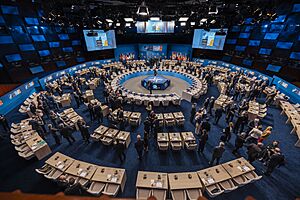
The summit brought together leaders from all 32 NATO member countries. Key figures included Mark Rutte, the NATO Secretary General, and the Prime Ministers or Presidents of each nation. The host country, the Netherlands, was represented by Prime Minister Dick Schoof.
Invited Non-NATO Members
Several non-NATO countries and organizations were also invited. The European Union was represented by its President. While Australia, Japan, and South Korea were invited, their Prime Ministers did not attend. However, New Zealand's Prime Minister, Christopher Luxon, was present. Ukrainian President Volodymyr Zelenskyy also attended.
United Kingdom's Role
Keir Starmer, the Prime Minister of the United Kingdom, promised to increase the UK's defense and security spending. The goal is to reach 5% of its economic output by 2035, meeting a NATO target. Starmer also announced that the UK would send 350 advanced air defense missiles to Ukraine. These missiles were paid for using £70 million from frozen Russian assets. They were quickly changed to be launched from the ground and delivered using UK-supplied Raven systems. Additionally, he announced the UK would buy 12 F-35A jets. These jets are expected to carry US atomic bombs, expanding the UK's nuclear capability to include airborne delivery.
Talking with Donald Trump
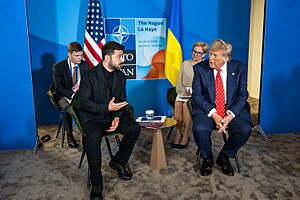
Before the summit, US President Donald Trump had often criticized the alliance. He mainly focused on other members not spending enough on defense. The summit was seen as a very important chance for Dutch diplomats to change his mind. They wanted to show how the Netherlands helps with international peace and security.
The dinner before the summit started with a speech from King Willem-Alexander. He personally invited Trump to stay at the palace as his guest. This was the first time such an invitation was given to a non-royal foreign leader. After a warm welcome, where Trump met Catharina-Amalia, Princess of Orange for the first time, the King specifically mentioned Article 3 of the NATO charter in his speech. He talked about the growing threat from Russia. This showed how the US and the Netherlands were working together to get all NATO countries to increase their spending to 5%.
Before the summit, Donald Trump shared private messages between himself and Mark Rutte on his Truth Social account. Some people thought Rutte might have written the messages knowing Trump would likely share them. This way, Rutte used Trump’s communication style to NATO’s benefit. Experts said Rutte adapted to Trump’s liking for open praise, even if it seemed too much by Dutch standards. Many agreed that Rutte’s methods, though they might seem overly flattering, were a planned risk that worked out well.
During the summit, Dutch and American diplomats worked together. They made sure the new agreement on the 5% GDP spending goal was accepted easily. This happened despite early resistance from Spain. In his comments to the media, President Trump spoke about his close relationship with Mark Rutte. He said he came to the summit for a specific reason but left feeling differently. He saw the leaders' love and passion for their countries, which he found amazing. He said they needed the United States and that NATO wouldn't work without it. He left feeling that these people truly loved their countries and that it wasn't a "ripoff." He felt they were there to help protect their countries. Media sources called the Dutch approach "flattery." Some suggested it changed President Trump's mind about NATO.
After talks with Ukrainian President Volodymyr Zelenskyy at the NATO summit, Trump said he was thinking about sending more Patriot missile batteries to Ukraine. This would help protect Kyiv from Russian attacks.
See also
- NATO summit
- 2024 Washington NATO summit
- Netherlands–United States relations
- Agreement on 5% NATO Defence Spending by 2035
- Spain–NATO 5% Military Spending Conflict


